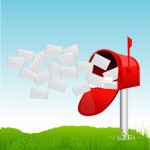 And you thought your in-box was already overflowing.
And you thought your in-box was already overflowing.
These days, many bloggers suggest people subscribe by email rather than to an RSS feed. Canada Post is encouraging consumers to sign up for epost, to get bills by email rather than snail mail. And businesses see the value of keeping in touch through regular newsletters that go straight to subscribers’ email.
If you haven’t already been taking steps to reduce email overload, now’s the time. Here are 12 tips for doing so:
1. Schedule times to deal with email. Writer Peter Bregman reports in the Harvard Business Review that he sets a timer and spends 30 minutes in the morning, mid-day and at the end of the afternoon. When the timer goes off, he closes his mail. (This is something I need to do, instead of leaving email open unless I’m working to a deadline!)
2. Send less mail and you’ll get fewer replies. Lifehacker suggests that each time you think about sending an email, you ask yourself, “Is this email absolutely necessary? Is email the best medium?” (Check out the funny decision tree infographic too.)
3. Use face-to-face more often. If you’re sending a message within the same building, try getting up and visiting in person. Haven’t you been sitting at your desk long enough anyway?
4. Pick up the telephone. How many times have you gone back and forth with someone (like ping pong!), trying to finalize or settle something by email, when a quick phone call would have been faster? Despite the speed of email, it’s not the best option when you urgently need a reply; use the telephone.
5. Avoid “reply all” unless it’s really necessary — and before you hit ‘send,’ think again if it’s really necessary to send it to everyone. David Peck writes for Huff Post Canada, “MUST you copy that person? (Helpful hint: ‘maybe’ = no.)”
6. Get to the point. You’ll need fewer explanations and less discussion if your first email is clear and concise. That includes the subject line.
7. If a back-and-forth discussion changes topic, change the subject line to match to avoid confusion.
8. Be clear about what action you require. Put this early in the message, not after a long explanation.
9. Use templates for messages you send frequently. Writing for Inc., Amy Buckner Chowdhry points out that “Many emails to employees, clients, or colleagues are similar in nature. Rather than constructing each one from scratch, save templates that remind you of important details to include.”
10. Use automatic filters. Have folders set up where you can direct items, like non-urgent mail you want to read later. Send “out of office” replies straight to trash.
11. Change your subscription options. If you get digests from a LinkedIn group, for example, opt for weekly updates over daily updates.
12. Unsubscribe. Maybe you signed up for a newsletter to get a free report, or just to be polite. If you get a couple of issues and you don’t read them, don’t just delete; unsubscribe, or change the frequency if you can.
Do you have other tips for reducing email overload? Please share in the comments.
Mailbox image: “digitalart” and FreeDigitalPhotos.net. Updated May 2019.

Great tips Sue — you’ve suggested some sensible and easy to implement tips. Now just need to do it! : )
Thanks, Ernesta! Yes, that’s the catch, isn’t it. I am particularly bad about #1. So do as I say, not as I do!
There are some good suggestions, although I actually recommend that you continue to use RSS feeds for information that you are fine “pulling” instead of needing it “pushed”.
I have other suggestion to reduce Email Overload on a site I am building.
Please feel free to check it out.
Regards,
Michael Einstein